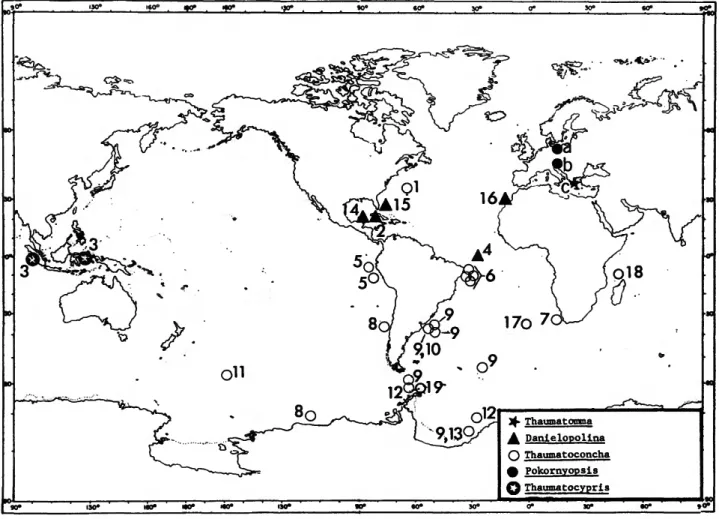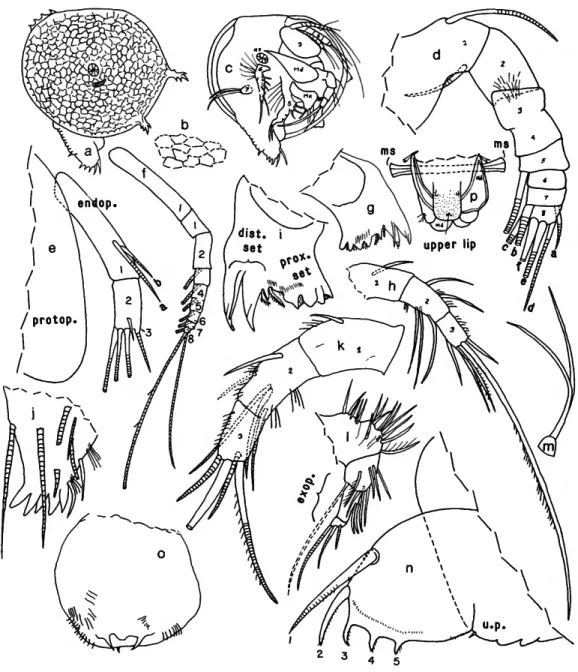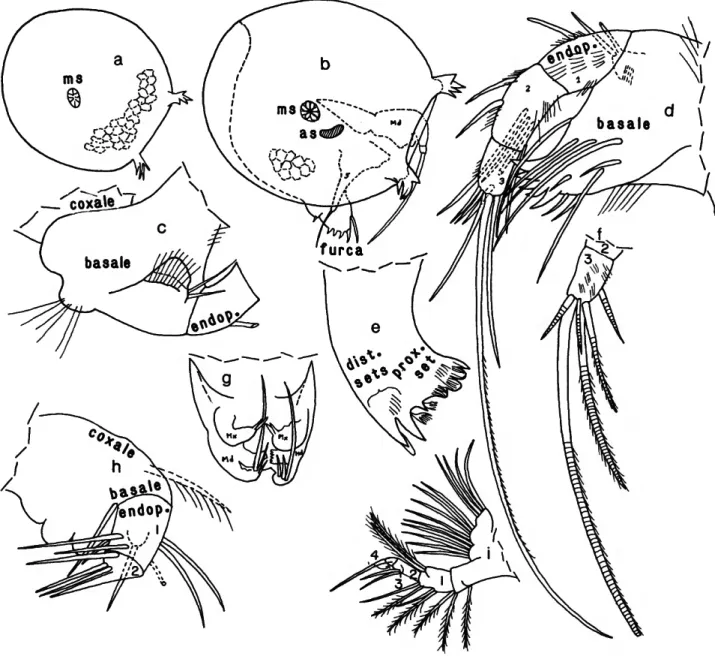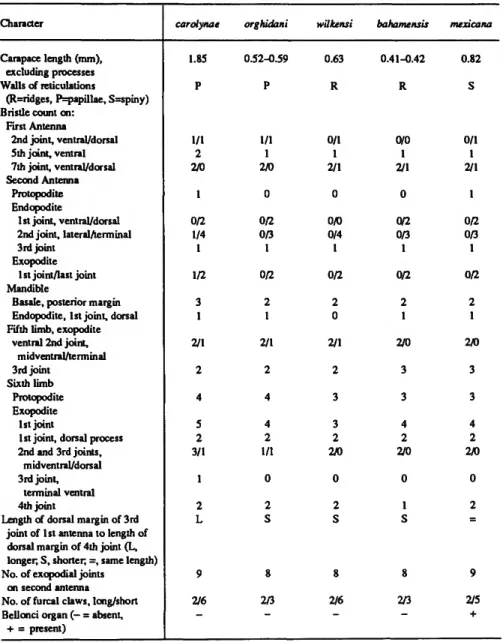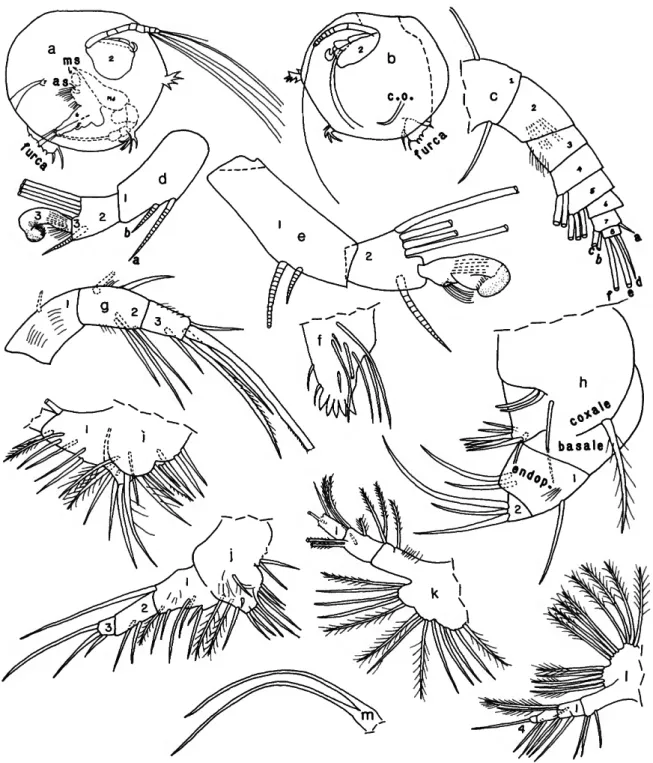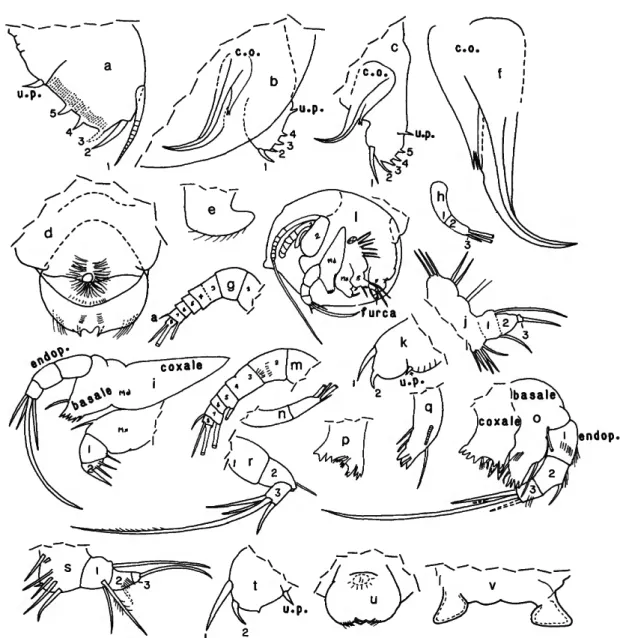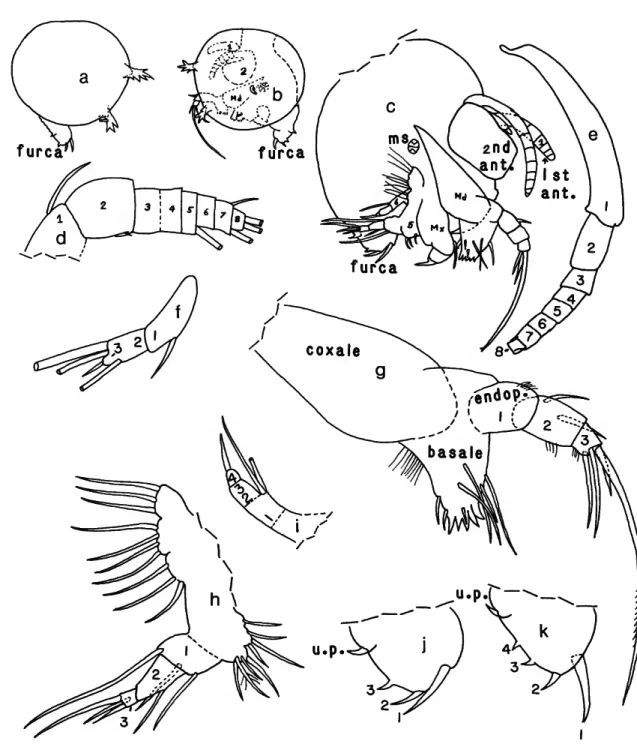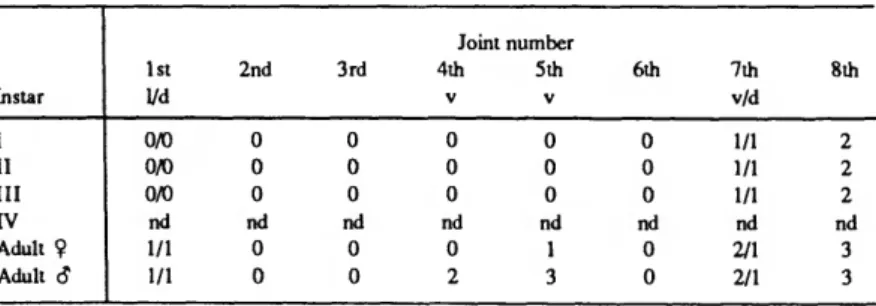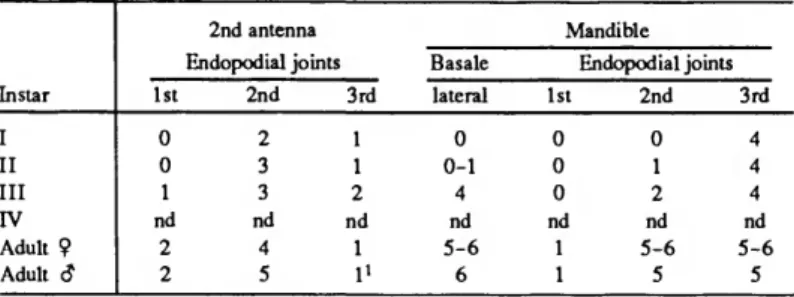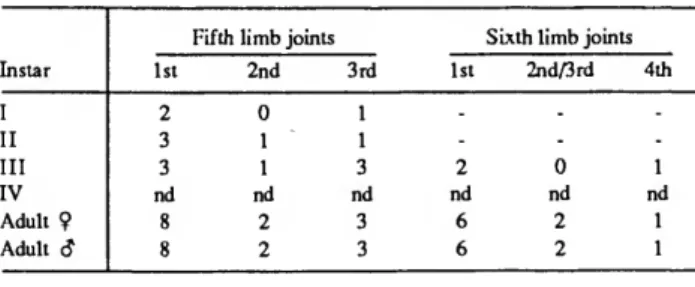New Ostracoda
(Halocyprida: Thaumatocyprididae and Halocyprididae) from
Anchialine Caves in the Bahamas, Palau, and Mexico
LOUIS S. KORNICKER and
THOMAS M. ILIFFE
SMITHSONIAN CONTRIBUTIONS TO ZOOLOGY • NUMBER 4 7 0
Emphasis upon publication as a means of "diffusing knowledge" was expressed by the first Secretary of the Smithsonian. In his formal plan for the Institution, Joseph Henry outlined a program that included the following statement: "It is proposed to publish a series of reports, giving an account of the new discoveries in science, and of the changes made from year to year in all branches of knowledge." This theme of basic research has been adhered to through the years by thousands of titles issued in series publications under the Smithsonian imprint, commencing with Smithsonian Contributions to Knowledge in 1848 and continuing with the following active series:
Smithsonian Contributions to Anthropology Smithsonian Contributions to Astrophysics
Smithsonian Contributions to Botany Smithsonian Contributions to the Earth Sciences Smithsonian Contributions to the Marine Sciences
Smithsonian Contributions to Paleobiology Smithsonian Contributions to Zoology
Smithsonian Folklife Studies Smithsonian Studies in Air and Space Smithsonian Studies in History and Technology
In these series, the Institution publishes small papers and full-scale monographs that report the research and collections of its various museums and bureaux or of professional colleagues in the world of science and scholarship. The publications are distributed by mailing lists to libraries, universities, and similar institutions throughout the world.
Papers or monographs submitted for series publication are received by the Smithsonian Institution Press, subject to its own review for format and style, only through departments of the various Smithsonian museums or bureaux, where the manuscripts are given substantive review.
Press requirements for manuscript and art preparation are outlined on the inside back cover.
Robert McC. Adams Secretary
Smithsonian Institution
S M I T H S O N I A N C O N T R I B U T I O N S T O Z O O L O G Y • N U M B E R 4 7 0
New Ostracoda
(Halocyprida: Thaumatocyprididae and Halocyprididae) from
Anchialine Caves in the Bahamas, Palau, and Mexico
Louis S. Kornicker and
Thomas M. Iliffe
SMITHSONIAN INSTITUTION PRESS Washington, D.C.
1989
Kornicker, Louis S., and Thomas M. Diffe. New Ostracoda (Halocyprida: Thaumatocypridi- dae and Halocypridididae) from Anchialine Caves in the Bahamas, Palau, and Mexico.
Smithsonian Contributions to Zoology, number 470,47 pages, 22 figures, 8 tables, 1989.—Four new ostracode taxa are described from anchialine environments. Danielopolina bahamensis, a thaumatocyprid, is described from Eleuthera, the Bahamas, based on 13 specimens.
Danielopolina mexicana is described from two specimens from the the Yucatan Peninsula, Mexico. This brings the number of known Danielopolina species to five; a revised key to the genus is included The description of D. bahamensis includes the first for a male of the genus.
Two new halocyprids are also described: Deeveya jillae, based on three specimens from Eleuthera, the Bahamas (bringing the number of known species of Deeveya to three); and a new subspecies, Euconchoecia bifurcata pax, based on 77 specimens from Koror Island, Palau.
Ontogeny is described for those taxa with sufficient specimens: Danielopolina bahamensis and E. bifurcata pax. D. bahamensis probably has five growth stages. E. bifurcata pax has seven. The first instar of each of these two species has five pairs of appendages (first and second antennae, mandible, maxilla, and fifth limb) in addition to a furca.
OFFICIAL PUBLICATION DATE is handstamped in a limited number of initial copies and is recorded in the Institution's annual report, Smithsonian Year. SERIES COVER DESIGN: The coral Montastrea cavernosa (Linnaeus).
Library of Congress Cataloging-in-Publication Data Komicker, Louis S., 1919-
Ncw Ostracoda (Halocyprida, Thaumatocyprididac and Halocyprididac) from anchialine caves in the Bahamas, Palau, and Mexico.
(Smithsonian contributions to zoology ; no. 470) Bibliography: p.
1. Thaumatocyprididae—Bahamas—Classification. 2. Thaumatocyprididac—Mexico—Classification. 3. Halo- cyprididae—Bahamas—Classification. 4. Halocyprididac—Palau—Classification. 5. Thaumatocyprididae—
Bahamas—Development. 6. Thaumatocyprididae—Mexico—Development. 7. Halocyprididae—Bahamas—
Development. 8. Halocyprididae—Palau—Development. 9. Crustacea—Classification 10. Crustacea—
Development. I. Iliffe, Thomas M. II. Title. III. Series.
QL1.S54 no.470 591s 88-600237 [QL444.08] [595.3'30972]
Contents
Page
Introduction 1 Terminology and Abbreviations 1 Methods 2 Acknowledgments 2 Order HALOCYPRIDA Dana, 1853 2 Suborder HALOCYPRIDINA Dana, 1853 2 Superfamily THAUMATOCYPRIDOIDEA Miiller, 1906 2 Family THAUMATOCYPRIDIDAE Muller, 1906 2 Danielopolina Kornicker and Sohn, 1976 2 Revised Key to the Species of Danielopolina 4 Danielopolina bahamensis Kornicker and Iliffe, new species 4 Comparison with Other Species of Danielopolina 12 Sexual Dimorphism 12 Number of Growth Stages 12 Ontogeny 14 Danielopolina mexicana Kornicker and Iliffe, new species 15 Comparison with Other Species of Danielopolina 19 Superfamily HALOCYPRIDOIDEA Dana, 1853 19 Family HALOCYPRIDIDAE Dana, 1853 19 Subfamily DEEVEYINAE Kornicker and Iliffe, 1985 19 Deeveya Kornicker and Iliffe, 1985 19 Key to the Species of Deeveya 19 Deeveya jillae Kornicker and Iliffe, new species 19 Comparison with Other Species of Deeveya 28 Ontogeny 28 Subfamily EUCONCHOECINAE Poulsen, 1969 29 Euconchoecia Muller, 1890 29 Euconchoecia bifurcata Chen and Lin, 1984 29 Euconchoecia bifurcata pax Kornicker, new subspecies 29 Comparison between Subspecies of Euconchoecia bifurcata . . 40 Ontogeny 42 Order of Appearances of Appendages 43 Furca 43 Bellonci Organ 44 Reproduction 45 Literature Cited 46
111
New Ostracoda
(Halocyprida: Thaumatocyprididae and Halocyprididae) from
Anchialine Caves in the Bahamas, Palau, and Mexico
Louis S. Kornicker and Thomas M. Iliffe
Introduction
An anchialine cave is one containing salt or brackish pools without surface connection with the sea, and which fluctuate with the tide (Iliffe et al., 1984:311). Within such caves, a remarkable fauna has recently been discovered, including many new taxa (Iliffe et al., 1983, 1984; Hart et al., 1985).
Knowledge of the ostracode suborder Halocypridina has been considerably enhanced by anchialine cave studies: the first troglobitic member of the suborder was described by Danielopol (1972,1976) from a cave in Cuba; the second from a cave in Bermuda (Angel, 1983:531; Angel and Iliffe, 1987);
the third from a cave in the Turks and Caicos Islands (Kornicker and Iliffe, 1985); the fourth from lava-tunnels in the Canary Islands (Hartmann, 1985; Wilkins et al., 1986) and the fifth from a "blue hole" in Andros Island, the Bahamas (Kornicker and Palmer, 1987). Here, three new anchialine species and one new anchialine subspecies are described from caves in the Bahamas, Palau, and the Yucatan Peninsula of Mexico.
TERMINOLOGY AND ABBREVIATIONS.—In the Halocyprid- ina, the maxilla bears one endite on the precoxale and a bifurcate endite on the coxale. Herein, the endite of the Louis S. Kornicker, Department of Invertebrate Zoology, National Museum of Natural History, Smithsonian Institution, Washington, DC. 20560. Thomas M. Iliffe, Bermuda Biological Station for Research, Ferry Reach GE 01, Bermuda.
Review Chairman: Roger F. Cressey, National Museum of Natural History, Smithsonian Institution. Reviewers: Martin V. Angel, Institute of Oceanographic Sciences, England; Thomas E. Bowman, National Museum of Natural History, Smithsonian Institution; I.G.
Sohn, US. Geological Survey.
precoxale is termed endite I and the proximal and distal parts of the coxale endite are termed endites II and III, respectively.
Furcal claws are numbered starting from the distal claw (claw 1).
For the seventh joint of the first antenna of the Thaumato- cyprididae, the dorsal bristle is designated the a-bristle when present (absent on Danielopolina orghidani and D. carolinae), the medial ventral bristle is designated the b-bristle, and the lateral ventral bristle is designated the c-bristle (either the b-or c-bristle is absent on Thaumatocypris echinata). For the eighth joint, the anterior bristle is designated the d-bristle, the stout lateral bristle at the midwidth of the joint is designated the e-bristle, and the bristle medial to the e-bristle is designated the f-bristle (absent on T. echinata).
In our discussion of Deeveya jillae, new species, we use a lettering system for bristles of joints 7 and 8 of the first antenna and for bristles of the endopodite of the 2nd antenna that Kornicker (in press) applies to Spelaeoecia bermudensis, slightly modified from its original application to D. bransoni by Kornicker and Palmer (1987:610). The designating letters and bristle positions are as follows. 1st antenna, 7th joint: a-, dorsal; b-, medial ventral; c-, lateral ventral. 1st antenna, 8th joint: d-, anterior; e-, stout lateral bristle near midwidth of joint; f-, medial, near midwidth of joint and with proximal part angled ventrally; g-, posterior, lateral to f-bristle and either slightly medial to or at same level as e-bristle. Endopodite of 2nd antenna, 1st joint: a- and b-, 2 dorsal bristles. Endopodite of 2nd antenna, 2nd joint: c-, d-, and e-, small bristles not found on all species; f- and g-, 2 long lateral and medial bristles, respectively. Endopodite of 2nd antenna, 3rd joint: h-, i-, j - , 3 long terminal bristles.
1
Use of the terms hair, spine, and bristle follow Poulsen (1962:8).
In the figures, Arabic numerals indicate limbs 1-7, as well as individual joints of each limb (the location of the numeral indicating whether a limb or joint is indicated). Roman numerals I—III indicate the endites.
The following abbreviations are used: ant., antenna; as, auxiliary muscle attachment; B.O., Bellonci organ; C O . , copulatory organ; disL, distal; endop., endopodite; esoph., esophagus; exop., exopodite; mast, pad, masticatory pad; Md, mandible; Mx, maxilla; ms, adductor muscle attachments; P.I., pars incisiva; protop., protopodite; prox., proximal; u.p., unpaired process.
USNM specimen numbers indicate the United States National Museum collections of the National Museum of Natural History (NMNH), Smithsonian Institution.
METHODS.—Specimen and environmental data collection were made by Iliffe. Specimens were first preserved in alcohol, and then in glycerine for about a month prior to examination by Kornicker. In specimens of Danielopolina bahamensis, carapace reticulations tended to flake off while the body was being removed from the shell. Although reticulations were intact and clear at the time of illustration, none of our glycerine preserved specimens of D. bahamensis have retained visible surface reticulation.
Specimens were measured with an ocular micrometer through a microscope and are reported to the nearest 0.01 mm.
Measurements are given as maximum length and height, each measured with specimen oriented in approximate living position, including or excluding processes as indicated.
Drawings were made with a camera lucida; most appendages were drawn with the appendage mounted in glycerine and under a cover slip. Some appendages were examined at x 100 under oil immersion.
ACKNOWLEDGMENTS.—Collection of specimens from the Bahamas, Mexico, and Palau was supported by National Science Foundation Grants (BSR 8215672 and BSR 8417494) to Thomas M. Iliffe. We are indebted to the College Center of the Finger Lakes Bahamian Field Station and its staff on San Salvador Island for logistical support in the Bahamas, and to Toshiro Paulis, Chief of the Division of Marine Resources, Republic of Palau, and Acting Director of the Micronesian Mariculture Demonstration Center, for information on cave locations and logistical support in Palau. We thank William Hamner (University of California, Los Angeles) for generously providing data on Lake 2a Cave, Palau, J. Bozanic and Dennis Williams for assisting with field collections in Palau, and Dinah Drago, Juan Fucat, John Markham (Arch Cape Marine Laboratory, Oregon), Michael Madden, and James Coke for providing information and assistance in Yucatan. We also thank Jack Schroeder for inking shell and appendage drawings, Robert P. Higgins (NMNH) for photographs in Figure 10, Thomas E. Bowman (NMNH) and Martin Angel (Institute of Oceanographic Sciences, Godalming, England) for criticizing
the manuscript, and Elizabeth Harrison-Nelson (NMNH) for general assistance. This paper is Contribution Number 1108 of the Bermuda Biological Station for Research.
Order HALOCYPRIDA Dana, 1853 Suborder HALOCYPRIDINA Dana, 1853
COMPOSITION.—The Halocypridina includes two superfa- milies: the Thaumatocypridoidea Miiller, 1906; and Halocypri- doidea Dana, 1853 (Kornicker and Sohn, 1976, fig. 2) (the ending -oidea rather than -acea is used herein for superfamilies, c.f., Kornicker and Sohn, 1976). The earliest known fossil Thaumatocypridoidea is from the Permian; the earliest known fossil Halocypridoidea is from the Cretaceous (Kornicker and Sohn, 1976:6).
Superfamily THAUMATOCYPRIDOIDEA Miiller, 1906 COMPOSITION.—Includes the single family Thaumatocyp- rididae Muller, 1906.
Family THAUMATOCYPRIDIDAE Muller, 1906 COMPOSITION.—This long ranging family (Permian to Holocene) includes five genera (Figure 1). Two are known only as fossils: Thaumatomma Kornicker and Sohn, 1976, from the Permian of Idhra Island, Greece; and Pokornyopsis Kozur, 1974, from the Upper and Lower Jurassic of southwestern and western Germany). Three are known only from the Holocene:
Thaumatocypris Muller, 1906, from off Sumatra (1100 m) and Indonesia (2000 m); Thawnatoconcha Kornicker and Sohn, 1976, from the Atlantic, Pacific, and Indian Oceans at depths ranging from 150 to 4758 m; and Danielopolina Kornicker and Sohn, 1976 (see "Composition," below).
Danielopolina Kornicker and Sohn, 1976
TYPE SPECIES.—Danielopolina carolynae Kornicker and Sohn, 1976.
COMPOSITION.—The genus includes five species: D. caro- lynae Kornicker and Sohn, 1976, from the mid-Atlantic (00°46'S, 29°24-28'W) at a depth of 3459 m; D. orghidani (Danielopol, 1972), from a saline grotto in Cuba; D. wilkensi Hartmann, 1985, from a marine lava-tunnel in the Canary Islands; D. bahamensis, new species, from a marine cave in Eleuthera, the Bahamas; and D. mexicana, new species, from a marine cave in Yucatan, Mexico. Hence, the entire genus Danielopolina inhabits anchialine or deep sea environments.
DIAGNOSES (EMENDED).—The original diagnosis of Daniel- opolina by Kornicker and Sohn (1976:93) was based on two species. Now including three additional species (two described herein), the genus requires an emended diagnosis.
Carapace: Surface reticulate or with abundant small
NUMBER 470
straight or curved spines. Boundaries of reticulations formed of either closely spaced minute subround papillae or of ridges of continuous or discontinuous segments (Figures 2a,b, 3a,b).
First Antenna: 1 st joint with 2 bristles (1 dorsal, 1 lateral);
7th joint with 2 ventral and 0 or 1 dorsal bristle; 8th joint with 3 bristles.
Second Antenna: Endopodite 3-jointed (but 2nd and 3rd joints of female endopodite fused): 1st joint with no ventral bristles and 0 or 2 dorsal bristles; 3rd joint dorsal and with sclerotized process on male.
Sixth Limb: Process on dorsal corner of 1 st exopodial joint with 2 bristles (limb and process absent in some growth stages).
Bellonci Organ: Absent, except for D. mexicana.
CORRECTION.—The senior author would like to take this opportunity to correct Kornicker and Sohn (1976). The adult of Danielopolina orghidani bears 3 short claws, not 4 (as in Kornicker and Sohn, 1976:9, table 1). The number of claws indicated by Kornicker and Sohn (1976) in their table 13 is correct.
J2L JS2L
• '^e-4>> •
Thamnatomna Danielopolina O Thaumat oconcha
£ Pokornyopsis O Thaumatocypris
ISO* WO* MO* 130*
FIGURE 1.—Distribution of living and fossil species of the Thaumatocyprididae, fossil species identified by a letter, living species by a numeral: a = Pokornyopsis bettenstaedti (Bartenstcin); b = P. feifeli (Treibel); c = Thaumatomma piscifrons Komicker and Sohn; 1 = Thaumatoconcha polythrix Kornicker and Sohn; 2 = Danielopolina orghidani (Danielopol); 3 = Thaumatocypris echinata Miiller, 4 = Danielopolina carolynae Komicker and Sohn; 5 = Thaumatoconcha elongata Komicker and Sohn; 6 = T. tuberculata Komicker and Sohn; 7 = 7! hessleri Komicker and Sohn; 8 = Thaumatoconcha species indeterminate (Komicker and Sohn, 1976); 9 = T. radiata Komicker and Sohn; 10 = 71 caraionae Komicker and Sohn; 1 1 = 7 ! punctata Komicker and Sohn; 12 = T. sandersi Komicker and Sohn; 13 = Thaumatoconcha species A (Komicker and Sohn, 1976);
14 = Danielopolina mexicana, new species; 15 = D. bahamensis, new species; 16 = D. wilkensi Hartmann; 17
= Thaumatoconcha species (Komicker, 1985); 18 = T. porosa Komicker, 19 = Thaumatoconcha species (Hartmann, 1986). (Map adapted from Komicker and Sohn, 1976, fig. 9.)
Revised Key to the Species of Danielopolina
1. Carapace with surface spines D. mexicana, new species Carapace without surface spines 2 2. Carapace longer than 1.5 mm, including processes D. carolynae Carapace shorter than 1.0 mm, including processes 3 3. Each lamella of furca with 6 short fused claws D. wilkensi Each lamella of furca with 3 short fused claws 4 4. Each valve with single posterodorsal process; walls of surface reticulations formed by subround papillae; 2nd joint of 1st antenna with 2 bristles . . . D. orghidani Each valve without single posterodorsal process; walls of surface reticulations
formed by ridges; 2nd joint of 1st antenna without bristles
D. bahamensis, new species Danielopolina bahamensis Kornicker and Iliffe, new species
FIGURES 1-6,9
ETYMOLOGY.—From the type locality.
MATERIAL.—The Bahamas, Eleuthera, Hatchet Bay, Hatchet Bay Cave (Figure 1), 15 June 1986, collected by Thomas M.
Iliffe with a 93 |im mesh plankton net from 0-3 m water depths. Holotype: USNM 193285, adult male on slide and in alcohol. Paratypes: USNM 193286 and 193287, each single adult females; USNM 193288, 10 juveniles (sex unknown).
DISTRIBUTION.—Known only from the Bahamas, Eleuthera, Hatchet Bay, Hatchet Bay Cave (Figure 1).
HABITAT.—Eleuthera, situated on the eastern margin of Great Bahama Bank, is a long, thin island composed of low hills of eolian limestone. Hatchet Bay Cave is located several km northwest of the settlement of Hatchet Bay and about 1 km inland from the west coast of Eleuthera.
Hatchet Bay Cave includes three levels: an entrance chamber floored with limestone breakdown contains inactive stalactites and stalagmites and is inhabited by a colony of bats; an extensive middle level, reached by ladder, contains dry passages and chambers of phreatic origin; the lowest level, also accessible by ladder, consists of a chamber half-filled with water (Figure 9). Maximum depth in the central depression of this anchialine pool was about 3 m. Surface water on 15 June 1986 had a salinity of 32°/oo, a temperature of 21.7°C and 6 ppm dissolved oxygen. No human-sized passages were observed to extend from this pool and no water currents were observed in it. Also collected from this pool were a possible new genus of calanoid copepod (Audun Fosshagen, pers.
comm.); a macellicephalan polynoid polychaete identified by Marian H. Pettibone (in litt., 1986) as perhaps a young Pelagomacellicephala iliffei, previously known only from the anchialine Conch Bar Cave, Turks and Caicos Islands (Pettibone, 1985); and the new ostracode species Deeveya jillae described herein.
DESCRIPTION OF ADULT FEMALE (Figures 2, 3, Table 1).—Carapace subround in lateral view with straight dorsal margin in vicinity of hinge and also straight margin between
anterior and anteroventral processes; ventral and posterior margins as well as anterior margin dorsal to anterior process evenly rounded; valves broadest at about midlength and midheight, in vicinity of adductor muscle attachments. Short anterior and anteroventral processes with bases just lateral to valve edge; each process bearing fragile spine-bearing frill (Figures 2a, 3a,b) that easily breaks off at slight touch with dissecting needle leaving smaller firm protuberance (Figure 2c) similar to those on species of Thaumatoconcha (see Kornicker and Sohn, 1976, fig. 19). Paratype (USNM 193287) with fragile serrate posterodorsal frill (Figure Id) that broke off when touched with dissecting needle (other specimens in collection without this frill).
Ornamentation: Surface finely reticulate with reticulation walls formed of both continuous and discontinous segments (Figures 2a,b, 3a,b).
Muscle Attachments (Figures 2a,c, 3a,b): Adductor muscle attachments central in location; subround with greatest diameter trending towards posterior end of hinge; consisting of several wedge-shaped segments more or less radially arranged, but difficult to discern in detail. Cresent-shaped auxiliary muscle scar located anteroventral to adductor muscle attachment (Figures 2a, 3b).
Carapace Size: USNM 193286, left valve, length without anterior process 0.41 mm, height 0.37 mm. Paratype, USNM 193287, left valve/right valve: lengths without processes, 0.41/0.42 mm; height 0.37/0.36 mm.
First Antenna (Figure 2c,d): Limb with 8 joints. 1st joint with 2 bare bristles (1 dorsal, 1 lateral near ventral margin). 2nd joint with distal medial spines. 3rd joint well defined from 4th by separation of sclerotized frame at ventral and dorsal margins, but without medial or lateral sutures. 3rd joint with proximal medial spines. 4th joint bare, dorsal edge longer than dorsal edge of 3rd joint but relationship reversed along ventral edge. 5th joint slightly smaller than 4th, with 1 long bare ventral bristle. 6th joint slightly smaller than 5 th. 7th joint about same size as 6th, with 2 long bare ventral b- and c-bristles and 1 short dorsal a-bristle. 8th joint smaller than 7th, with 1 short d-bristle and 2 long bare e- and f-bristles.
NUMBER 470
FIGURE 2.—Danielopotina bahamensis, new species, USNM 193287, paratype, adult female: a, complete specimen, right side, showing position of central adductor muscle and auxilary muscle, attachments (length of right valve, excluding processes, 0.42 mm); b, detail of reticulations of right valve surface about half way between adductor muscle attachments and ventral margin (x 2 magnification of a); c, specimen, with right valve removed (not all appendage bristles shown); d, left 1st antenna, medial view (distal parts of some bristles not shown); e, endopodite and part of protopodite of right 2nd antenna, lateral view; / , exopodite of right 2nd antenna, lateral view; g, right mandibular coxale, lateral view; h, right mandibular endopodite, lateral view; i, coxale, left mandible, lateral view; j , basale, left mandible, lateral view; k, endopodite, left mandible, lateral view; /, left 5th limb; m, left 7th limb; n, left lamella of furca, lateral view; o, upper lip, posterior end at bottom; p, anterior view of body showing upper lip (stippled), anterior view of parts of mandibles, and adductor muscle. (Figure components not to same scale.)
Second Antenna (Figure 2c,e,f): Protopodite bare. Endopo- dite (Figure 2e): 1st joint elongate with 2 dorsal a- and b-bristles; 2nd joint with ventral and dorsal margins parallel, about 72 length of 1st joint, with 1 short lateral bristle and 3 long terminal bristles; 3rd joint small, fused to 2nd, with short
terminal bristle. Exopodite (Figure If) with 8 joints: 1st joint divided weakly into long proximal and short distal parts;
bristles of joints 2-7 long, ringed and with minute, widely separated, marginal spines, and natatory hairs; 8th joint with 2 bristles (1 long, 1 medium), both with minute widely
FIGURE 3.—Danielopolina bahamensis, new species, USNM 193286, paratype, adult female: a, complete specimen, right side, showing reticulations and position of central adductor muscle (length of carapace excluding processes 0.41 mm); b, same as a, showing central adductor muscle, auxiliary muscle attachments, and positions of right mandible, right 5th limb, and projecting furca; c, proximal right mandible showing spines and bristles of basale, medial view; d, basale and endopodite of left mandible, lateral view; e, tip of coxale of right mandible, medial view;/, tip of endopodite of right mandible, medial view; g, ventral view of body showing positions of maxillae and mandibles (most bristles not shown); h, maxilla (endites not shown); i, 6th limb. (Figure components not to same scale.)
NUMBER 470
separated marginal spines (illustrated on only 1 bristle, Figure 20-
Mandible (Figures 2c,g-k,p, 3b-g): Coxale endite with proximal and distal sets of teeth separated by space (Figures 2g,i, 3e); proximal set comprising 4 broad cusps plus triangular tooth close to distal set of teeth; surface between cusps and medial and lateral surfaces just proximal to cusps with slender spines; 1 spinous bristle with base just proximal and another spinous bristle with base just distal to triangular tooth; distal set of teeth consisting of 2 flat teeth, each having at least 3 pointed cusps; 1 slender pointed bristle with base on lateral
side of flat teeth. Basale (Figures 2j, 3c,d): tooth of endite with 5 triangular cusps; posterior edge of endite with 1 proximal bristle and 1 distal blunt bristle; anterior margin of endite with 1 long bristle; lateral side of endite with 4 or 5 slender proximal bristles and 1 shorter distal ringed bristle; medial side with 2 proximal bristles on low spinous mound. Endopodite 3-jointed with 1st and 2nd joints about same length and 3rd joint shorter (Figures 2c,hX 3b-d,f,g); 1st joint with long lateral and dorsal spines and 1 dorsal bristle; 2nd joint spinous, with 1 distal ventral bristle, 2 or 3 medial bristles near ventral margin, and 2 dorsal bristles; 3rd joint spinous, with 6 bristles (1 long,
TABLE 1.—Comparison of selected characters of female Danielopolina. Specimens are adults, except for D.
mexicana which is probably A-1. Information on carolynae comes from Komicker and Sohn (1976), on orghidani from Danielopol (1972, 1976) and Komicker and Sohn (1976), and on wilkensi from Hartmann (1985).
Character
Carapace length (mm).
excluding processes Walls of reticulations
(R=ridges, P=papillae, S=spiny) Bristle count on:
First Antenna
2nd joint, ventral/dorsal 5th joint, ventral 7th joint, ventral/dorsal Second Antenna
Protopodite Endopodite
1 st joint, ventral/dorsal 2nd joint, lateral/terminal 3rd joint
Exopodite 1st joint/last joint Mandible
Basale, posterior margin Endopodite, 1st joint, dorsal Fifth limb, exopodite
ventral 2nd joint.
midventra I/terminal 3rd joint
Sixth limb Protopodite Exopodite
1 st joint
1 st joint, dorsal process 2nd and 3rd joints,
mid ventral/dorsal 3rd joint,
terminal ventral 4th joint
Length of dorsal margin of 3rd joint of 1st antenna to length of dorsal margin of 4th joint (L, longer, S, shorter; =, same length) No. of exopodial joints
on second antenna No. of furcal claws, long/short Bellonci organ (— = absent.
+ = present)
carolynae
1.85 P
1/1 2 2/0
1 0/2 1/4 1 1/2
3 1 2/1
2 4 5 2 3/1
1 2 L
9 2/6
-
orghidani
0.52-0.59 P
1/1 1 2/0
0 0/2 0/3 1 0/2 2 1 2/1 2 4 4 2 1/1
0 2 S
8 2/3
-
wilkensi
0.63 R
0/1 1 2/1
0 0A) 0/4
1 0/2
2 0 2/1
2 3 3 2 2/0
0 2 S
8 2/6
-
bahamensis
0.41-0.42 R
0/0 1 2/1
0 0/2 0/3 1 0/2
2 1 2/0
3 3 4 2 2/0
0 1 S
8 2/3
-
mexicana
0.82 S
0/1 1 2/1
1 0/2 0/3 1 0/2
2 1 2/0
3 3 4 2 2/0
0 2
=
9 2/5
+
terminal, lateral bristle about twice length of endopodite and with ventral spines, 2 medium length bristles, and 3 shorter bristles); 3rd joint of limbs of USNM 193287 (Figure 2h,k) with 4 - 5 bristles but limbs somewhat fragmented and bristles may have been torn away.
Maxilla (Figures 2c, 3g,h): Endite I with 10 bristles; endite II with about 7 bristles; endite III with 3 or more bristles; some bristles on each endite stout pectinate. Coxale with long stout dorsal plumose bristle. Basale with long slender ventral bristle.
Endopodite (Figure 3h): 1st joint with 3 anterior (dorsal) bristles, 3 posterior (ventral) bristles, and 1 medial (or lateral) bristle; end joint with 1 anterior, stout, linear, sclerotized bristle without a visible suture at the base, and 3 slender, ringed bristles.
Fifth Limb (Figures 2c,/, 3b): Epipodite with bristles forming 3 groups, each with 4 plumose bristles. Protopodite and endopodite with about 15 bristles; distal endopodial joint with short tooth-like bristle. Exopodite 3-jointed: 1st joint with 1 very long terminal bristle near dorsal margin and 7 bristles closer to or on ventral margin; 2nd joint elongate with 2 midbristles on ventral margin; 3rd joint small with 3 bristles (middle bristle 63% and smallest bristle 31% length of longest bristle).
Sixth Limb (Figures 2c, 3i)' Epipodite with bristles forming 3 groups (5 bristles in proximal group, 4 in each distal group). Protopodite with 3 ventral bristles (1 proximal, 2 terminal). Exopodite 4-jointed: 1st joint divided by weak suture into proximal part with 2 ventral bristles, and shorter distal part with 2 ventral bristles; small process with 2 long plumose bristles present on dorsal corner of terminal margin of 1st joint;
2nd and 3rd joints completely fused, with 2 ventral bristles just distal to midlength; 4th joint with 1 long terminal bristle.
Seventh Limb (Figure 2c,m): Small with 2 long bristles.
Furca (Figures 2a,c,n, 3b): Each lamella with 2 long anterior articulated claws followed by 3 short ventral nonarticulated claws; 1st anterior claw weakly ringed; posterior edges of all claws with faint spines; anterior claw edges with a few spines near tip; lateral surface of lamella with minute spines forming row, more and longer spines on medial surface (not shown on illustration); small unpaired process on posterior of body just proximal to lamellae.
Bellonci Organ: Absent.
Lips: Upper lip with 2 pointed processes oriented posteri- orly (Figure 2oj)). Lower lip with 2 lateral triangular processes (1 on each side) oriented anteriorly; anterior apex rounded.
Gut Content: Brown unidentified particles.
DESCRIPTION OF ADULT MALE (Figures 4, 5a-/).—
Carapace (Figure Aa,b) similar in shape and surface patterning to that of adult female but lacks posterodorsal frill in this specimen (USNM 193285; tip may have broken off).
Carapace Size: USNM 193285, holotype, left valve/right valve lengths including anterior process 0.43/0.42 mm, lengths without anterior process 0.40/0.40 mm, heights 0.35/0.33 mm.
First Antenna (Figure 4c): 1st joint with 2 bristles (1
ventral, 1 dorsal). 2nd joint with distal medial spines. 3rd joint spinous, separated from 4th joint by distinct suture; ventral margin longer and dorsal margin shorter than that of 4th joint.
4th joint with 2 long bare ventral bristles. 5th joint with 3 long ventral bristles (2 bare or with widely separated, minute, marginal spines, 1 with abundant, short, distal hairs). 6th joint bare. 7th joint with 2 long, bare, ventral b- and c-bristles and 1 short, bare, dorsal a-bristle. 8th joint with 2 long e- and f-bristles (bare or with widely spaced, minute, marginal spines) and 1 shorter bare d-bristle dorsal to others.
Second Antenna (Figure Aa,b,d,e): Protopodite bare. Endo- podite: 1st joint elongate with 2 dorsal a- and b-bristles; 2nd joint short, broadening distally and with 5 bristles (2 long and 2 medium near ventral edge, 1 short near dorsal edge, with base on lateral side); 3rd joint small, with terminal sclerotized hook-like process with row of short spines along distal edge, and row of longer proximal spines. Exopodite similar to that of female, except natatory hairs on bristles appear more numerous. [Kornicker and Sohn (1976:50, fig. 33) interpreted the hook-like terminal process on the endopodite of Thaumata- concha radiata to be a modified 3rd joint; the process on thaumatocypnds is reinterpreted herein to be a modified bristle on a small 3rd joint.]
Mandible (Figure Aa,f,g): Similar to that of adult female (Figure 2g-k, 3c-/).
Maxilla (Figure Ah): Only 2 endites observed (aberrant?).
Coxale with 1 spinous dorsal bristle. Basale obscured, no ventral bristle observed. Endopodite: 1st joint with 1 anterior and 2 posterior bristles. End joint: 1 limb similar to that of adult female, other with 3 terminal bristles, each with suture at base. (In the Thaumatocyprididae, maxillae are usually similar between sexes; differences observed here may result from an aberrant maxilla on our single male specimen.
Aberrant appendages are occasionally encountered in ostra- codes.)
Fifth Limb (Figure Aa,i,j): Epipodite with 11 bristles forming 3 groups with 3 bristles in proximal group and 4 in middle and distal groups. Distributions of bristles of protopo- dite, endopodite, and exopodite similar to those of adult female.
3rd (end) joint: middle bristle 58% and smallest bristle 28%
of longest bristle.
Sixth Limb (Figure Aa,k,t) and Seventh Limb (Figure Aa,m): Similar to those of adult female.
Furca (Figures Aa,b, 5a-c): Similar to that of adult female;
small unpaired process proximate to lamellae larger than on adult female.
Bellonci Organ: Absent.
Lips (Figure 5d,e): Similar to those of adult female.
Copulatory Organ (Figure Sb.cf): Single organ on left side of body; anterior part with long recurved process tapering to narrow tip; posterior styliform process with 3 faint hairs at tip.
Gut Content: Brown paniculate matter similar to that in gut of adult female.
NUMBER 470
FIGURE 4.—Danielopolina bahamensis, new species, USNM 193285, holotype, adult male: a, complete specimen, right side, showing positions of 2nd antenna, mandible, 5th, 6lh, and 7th limbs, and projecting furca (length of right valve excluding processes 0.38 mm); b, complete specimen, left side, showing 2nd antenna and tip of penis; c, right 1st antenna, lateral view; d, endopodite of left 2nd antenna, medial view; e, endopodite of right 2nd antenna, medial view;/, basale of right mandible, lateral view; g, endopodite of right mandible, lateral view; h, aberrant maxilla; i,j, right and left 5th limbs, respectively; k,l, right and left 6th limbs, respectively; m, right 7th limb. (Figure components not to same scale.)
DESCRIPTION OF INSTAR I, SEX UNKNOWN (Figure 5g-l).—
Carapace similar to that of adult but reticulations not present (Figure 5/). The specimen studied was a whole-mount with the right valve folded back. A glass cover slip was placed over the specimen, which was studied at x 100 under oil immersion.
Some of the appendages and parts were obscured (1st antenna, endopodite of 2nd antenna, coxale of mandible, endites of maxilla).
Carapace Size: USNM 193288C, length without anterior process 0.18 mm, height 0.15 mm.
First Antenna (Figure 5g,Q: Joints 1-6 without bristles;
suture between 3rd and 4th joints partially fused; 4th joint slightly longer than 3rd. 7th joint with long ventral bristle and faint short dorsal bristle. 8th joint with 2 bristles, 1 long, 1 short.
Second Antenna (Figure 5h,l): Protopodite bare, like adults. Endopodite (Figure 5/): 1st joint bare; fused 2nd and 3rd joints with 3 bristles (2 long, 1 short). Exopodite: 1st joint not divided; joints 2-7 each with long bare bristle; 8th joint with 2 bare bristles, 1 long, 1 short.
Mandible (Figure 5/,/): Coxale obscured in specimen.
Basale with 1 anterior bristle, 2 short posterior bristles, and no lateral bristles; proximal medial bristles not observed but could be obscured. Endopodite: joints 1 and 2 bare; 3rd joint with 4 bristles (1 very long, 3 short).
Maxilla (Figure 5i,[): Similar to that of adult but with fewer bristles.
Fifth Limb (Figure 5j,t): Epipodite with 3 lobes, each with 2 or 3 bristles. Protopodite and endopodite with 5 or more bristles. Exopodite: 1st joint with 1 very long terminal bristle near dorsal margin and 1 ventral bristle; 3rd joint with 1 terminal bristle.
Sixth and Seventh Limbs: Absent.
Furca (Figure 5k,l): Each lamella with 2 long anterior claws with only anterior of these articulated. Unpaired process on posterior of body proximal to lamellae well-developed.
Bellonci Organ: Absent
Lips: Obscured, but in general similar to those of adult.
Gut Content: Unidentified amber colored material.
DESCRIPTION OF INSTAR II, SEX UNKNOWN (Figure 5m-v).—
Carapace with shape similar to that of adult female, but lacking reticulations.
Carapace Size: USNM 193288E, length with anterior process 0.26 mm, length without anterior process 0.25 mm, height 0.21 mm.
First Antenna (Figure 5m): Joints 1-4 without bristles; 3rd joint slightly longer than 4th and fused to 4th except along dorsal edge. 5th joint with broad ventral bristle rounded at tip and just reaching to 7th joint (bristle may be broken, but is similar on both limbs of the single specimen examined. 6th joint without bristles. 7th joint with short dorsal bristle and long ventral bristle. 8th joint with 2 terminal bristles (1 short dorsal and 1 long ventral).
Second Antenna (Figure 5n): Protopodite similar to that
of adult. Endopodite: 1st joint elongate without bristles. 2nd and 3rd joints fused, with 1 short and 3 long bristles (2 broad, 1 slender). Exopodite: 1st joint not divided; 2nd-7th joints each with 1 long ringed bristle (no hairs observed on bristles);
8th joint with 1 long and 1 shorter ringed bristles (no hairs observed on bristles).
Mandible (Figure 5o-r): Coxale similar to that of adult.
Basale: with 1 proximal medial bristle; tooth of endite with only 4 triangular cusps; lateral side with 1 long proximal bristle, 1 long slender anterior bristle and 2 short posterior bristles, and terminal teeth similar to those of adult.
Endopodite: 1st joint without bristles; 2nd joint with 1 bristle;
3rd joint with 4 bristles (1 very long, 3 short).
Maxilla: Similar to that of adult female but with fewer bristles.
Fifth Limb (Figure 5s): Epipodite with at least 6 bristles.
Protopodite and endopodite with 6 bristles. Exopodite 3- jointed: 1st joint with 1 very long terminal dorsal bristle and 2 bristles near ventral margin; 2nd joint with 1 indistinct bristle near ventral margin; end joint with 1 long bristle.
Sixth and Seventh Limbs: Absent.
Furca (Figure 5t): Each lamella with 2 long articulated anterior claws followed by small triangular protuberance.
Unpaired process on posterior of body just proximal to lamellae well-developed.
Bellonci Organ: Absent.
Lips (Figure 5u,v): Similar to those of adult.
Gut Content: Brown unidentified particles.
DESCRIPTION OF INSTAR III, SEX UNKNOWN (Figure 6).—Carapace similar in shape and ornamentation to that of adult female (frill missing from anterior and anteroventral process of USNM 193288D) (Figure 6a,b).
Carapace Size: USNM 193288A, length with anterior process 0.30 mm, length without anterior process 0.28 mm, height 0.23 mm; USNM 193288B, length with anterior process 0.30 mm, length without anterior process 0.27 mm, height 0.23 mm; USNM 193288D, length without anterior process 0.30 mm, height 0.23 mm.
First Antenna (Figure 6b-d): 1st joint obscured but with dorsal brisde. Suture between 3rd and 4th joints obscured. 5th joint with long ventral bristle. 6th joint bare. 7th joint with short dorsal bristle and long ventral bristle. 8th joint with 2 long bristles.
Second Antenna (Figure 6b,c,e,f): Protopodite similar to that of adult. Exopodite similar to that of adult female except 1st joint not subdivided and natatory hairs not observed on bristles. Endopodite: 1st joint with 1 dorsal bristle; 2nd joint with 3 long terminal bristles (unlike adult female one of these bristles located near dorsal corner); 3rd joint small, fused to 2nd, with short terminal bristle.
Mandible (Figure 6b,c,g): Coxale and basale similar to those of adult female, except lateral side of basale with 3 proximal and 1 distal bristles. Endopodite: 1st joint with dorsal spines but no bristle; 2nd joint with spines and 2 short bristles;
NUMBER 470 11
/ d / \ \
i lendop.
FIGURE 5.—Danielopolina bahamensis, new species (a-f, USNM 193285, holotype, adult male; g-l, USNM 193288C, paratype, instar I, sex unknown; m-v, USNM 193288E, paratype, instar II, sex unknown): a, right furcal lamella; b, left furcal lamella and copulatory organ as seen through left valve; c, same as b, shell removed;
d, upper lip, posterior end at bottom; e, lower lip, anterior end at right; / , medial view of copulatory organ; g, left 1st antenna, lateral view; A, endopodite of left 2nd antenna, lateral view; i, left maxilla and mandible, lateral view; j , left 5th limb, lateral view; k, left lamella of furca; /, left view of juvenile specimen with left valve removed showing position of appendages (not all bristles shown); m, right 1st antenna, medial view; n, endopodite of left 2nd antenna, medial view; o, left mandible, medial view; p, coxale of right mandible, lateral view; q, basale of right mandible, lateral view; r, endopodite of right mandible (twisted); s, right 5th limb, medial view; t, left lamella of furca; u, upper lip, anterior view (outline of mouth as seen through lip is dashed);
v, lower lip (flattened under cover slip, outer ends of triangular processes oriented anteriorly in natural position).
(Figure components not to same scale.)
3rd joint with spines and 1 long and 3 short bristles.
Maxilla (Figure 6c): Similar to that of adult female but with fewer bristles.
Fifth Limb (Figure 6c,h): Epipodite with bristles forming 3 groups: 3 bristles in proximal and distal groups, and 4 bristles in middle group. Protopodite and endopodite each with about 8 bristles. Exopodite 3 jointed: 1st joint with 1 very long terminal bristle near dorsal margin, 1 distal medial bristle, and 1 distal ventral bristle; 2nd joint elongate with 1 ventral bristle;
3rd joint with 1 long and 2 short bristles.
Sixth Limb (Figure 6i): Epipodite not observed. No bristles observed on protopodite. Exopodite four-jointed: 1st joint with 2 terminal dorsal bristles; 2nd and 3rd joints fused and without bristles; 4th joint with short terminal bristle.
Seventh Limb: Absent.
Furca (Figure 6/Jfc): Each lamella with 2 long anterior claws separated from lamella by suture followed by 1 short ventral claw fused to lamella (left lamella of USNM 193288D with 2 short fused claws, Figure 6k); unpaired process on posterior of body just proximal to lamellae well-developed.
Bellonci Organ: Absent.
Lips: Similar to those of adult.
Gut Content: Brown unidentified particles.
COMPARISON WITH OTHER SPECIES OF Danielopolina The surface reticulations of the new species D. bahamensis resemble those of D. wilkensi (Hartmann, 1985, fig. la) in having walls formed in part by continuous ridges and in part by intermittant ridges. In contrast, other species of Danielopo- lina (D. orghidani and D. carolynae) have walls of reticulations formed by closely spaced minute subround papillae (Kornicker and Sohn, 1976, figs. 71-76). The left valve of D. wilkensi bears a process at the posterodorsal corner that is absent on D.
bahamensis. The appendages of D. bahamensis differ from those of D. wilkensi, most notably in having three instead of six small fused claws on each furcal lamella. The furca of D.
bahamensis resembles that of D. orghidani, but the valves of the latter species, as well as those of D. carolynae, bear posterodorsal processes absent on valves of D. bahamensis.
Selected characters of females of the five known species of Danielopolina are compared in Table 1.
SEXUAL DIMORPHISM
Carapace of adult male and female similar in shape and ornamentation. Length of left valve of unique male (excluding processes) 0.40 mm, lengths of left valves of 2 females 0.41 mm.
First Antenna: 3rd and 4th joints partially fused on female and separated by distinct suture in male. Ventral margin of 4th joint without bristles on female and with 2 long bristles on male. 5th joint with 1 bare bristle on female; and 3 bristles on male, longest with abundant distal hairs.
Second Antenna: Endopodite: 2nd joint with 4 bristles on female and 5 on male; ventral and dorsal margins of 2nd joint parallel on female, flaring on male. 3rd joint of female small, about xh width of 2nd joint and bearing small terminal bristle;
3rd joint of male about xli width of 2nd and bearing stout hook-like process bearing spines.
Copulatory Organs: Male with single copulatory organ having long curved anterior part with slender tip, and shorter styliform posterior part with 3 hairs at tip. Genital pore obscured on female.
Posterior of Body: Pointed process just posterior to furcal lamellae better developed on male than on female.
Other Appendages: Observed differences may be the result of variability within the species. The maxillae of male and female D. bahamensis differ, but this is attributed to the limb of our single male being aberrant. The epipodites of the 5th limbs of 1 male and 2 females examined have 11 bristles on the male and 12 on the female, but additional limbs should be studied to determine the constancy of the numbers; females of D. carolynae and D. orghidani have 14 cpipodial bristles.
Remarks: Sexual dimorphism has not previously been reported in Danielopolina. The dimorphisms described here for D. bahamensis are similar to those observed by Kornicker and Sohn (1976:16, table 13) for species of Thaumatoconcha.
An exception is that the 2nd endopodial joints of the 2nd antennae of male and female Thaumatoconcha have the same number of terminal bristles (4); that joint of D. bahamensis has 4 terminal bristles on the male and only 3 on the female.
Also, the hook-like process on the 3rd joint of the 2nd antenna of the male D. bahamensis bears abundant long spines that are absent on this process on known males of Thaumatoconcha.
NUMBER OF GROWTH STAGES
The 10 juveniles in this collection include 3 growth stages, interpreted to be instar III (8 specimens), instar II (1 specimen), and instar 1(1 specimen). Our conclusion that we lack the instar IV stage is based mostly on the absence of specimens with 2 short claws on the furcal lamellae. In the Thaumatocyprididae only the ontogeny of Thaumatoconcha radiata is fairly well known (Kornicker and Sohn, 1976:7); no comparative data exists on the ontogeny of Danielopolina species. Kornicker and Sohn (1976:40, table 1) have shown that each lamella of the furca of T. radiata increases the number of short furcal claws by 1 at each succeeding growth stage. Angel (1970:192) and Kornicker and Angel (1975: table 1) have shown that 3 species of Bathyconchoecia also add 1 claw on the furca in succeeding growth stages. The adult D. bahamensis bears 3 short furcal claws on each lamellae and the next younger growth stage in the present collection bears only 1 short furcal claw indicating it is probably an instar III.
Also, the growth factor of 1.46, obtained by dividing the length of the adult female by the length of next smaller instar, is much higher than the growth factor of 1.13 obtained for the
NUMBER 470 13
FIGURE 6.—Danielopolina bahamensis, new species, instar III, paratypes (a, USNM 193288A; b, USNM 193288B; c-k, USNM 193288D): a, complete specimen, right side, showing projecting furca (length of carapace excluding processes 0.28 mm); b, complete specimen, left side, showing position of appendages (length of carapace excluding processes 0.27 mm); c, body removed from carapace (length excluding processes 0.30 mm) showing positions of appendages (not all bristles of appendages shown); d, right 1 st antenna, lateral view; e, exopodite of right 2nd antenna, lateral view; / , endopodite of right 2nd antenna, lateral view; g, right mandible, lateral view, lip of coxale not shown; h, right 5th limb, lateral view; »', right 6th limb, lateral view; j,k, right and left lamella of furca, respectively. (Figure components not to same scale.)
adult and A-l females of T. radiata by Kornicker and Sohn (1976: table 2). But, as only a small number of specimens of Danielopolina bahamensis are available, this comparison may be unreliable. The large differences between the adults and next smallest stage in our collection in the number of bristles on the mandibular endopodite (Table 3), as well as on the 1st exopodial joints of the 5th and 6th limbs (Table 4) also suggest that an instar is missing from our sample.
Kornicker and Sohn (1976:8) concluded that T. radiata has 7 growth stages. In the present collection of D. bahamensis we cannot be certain that the single youngest specimen (USNM 1932886) is a 1st instar. That specimen is 0.18 mm in length.
The 93 fim net with which our collection was made has sufficiently small openings to have captured specimens considerably smaller than 0.18 mm, if they had been in its path.
Based on the first appearance of the 6th limb, we tentatively conclude that D. bahamensis has only 5 growth stages (instar I-adult). Limb 6 (bearing bristles) appears first on T. radiata in the 3rd instar. It seems reasonable to assume that it would appear in the same instar on D. bahamensis. The 7th limb appears first on T. radiata in the 4th instar but, unfortunately, that instar of D. bahamensis is not in our collection.
It seems probable that D. orghidani, which like D.
bahamensis has only 3 short fused furcal claws on each lamella, also has but 5 growth stages. D. wilkensi and D. carolynae, which have 6 short fused furcal claws like T. radiata, have 7 growth stages (Kornicker and Sohn, 1976, table 1).
ONTOGENY
In both D. bahamensis and T. radiata, the 1st and 2nd antennae, mandible, maxilla, 5th limb, and furca are already present in the 1st instar, but the 6th and 7th limbs are not. The 6th limb appears in both species with just a few bristles, in the 3rd instar. The 7th limb appears on the 4th instar of T. radiata and probably of D. bahamensis, but that instar is not in our collection. The carapaces of all known stages of D. bahamensis are similar except for size; all probably have frill-like anterior and anteroventral processes, but these fragile frills have been broken off some of the specimens. All specimens of D.
bahamensis have anterior and anteroventral triangular proc- esses underlying the frills.
Kornicker and Sohn (1976: table 5) listed the order of appearances of bristles on the 1st antenna of T. radiata. The total number of bristles on the 1st antenna of adult D.
bahamensis (9 on female, 13 on male) is lower than that of adult T. radiata (13 or 14 on female, 15 on male). On T.
radiata the number of bristles increases in each succeeding stage for the first 4 stages and then remains constant for the later stages (instars V, VI, and the adult). The number of bristles on the 1st antenna of D. bahamensis increases during the first 3 stages and additional bristles are present on the adult (the 4th stage is absent from our collection) (Table 2). In both species bristles appear on distal joints (5th, 7th, 8th) earlier than on proximal joints.
Kornicker and Sohn (1976, table 6) listed the order of appearance of bristles on the endopodite and exopodite of the 2nd antenna of T. radiata. The total number of bristles on the 2nd antenna endopodite of adult D. bahamensis (7 on female, 8 on male, including process) is lower than that of adult T.
radiata (11 on female, 9 on male, including process). On both species bristles appear on the 2nd and 3rd joint before appearing on the 1st joint. The number of bristles on the end joint (9th joint) of the exopodite of the 2nd antenna of T.
radiata increases from 1 on instar I to 3 on the adult; the number of bristles on the end joint (8th joint) of D. bahamensis remained the same (2 bristles) on all instars. The natatory hairs on the exopodial bristles are not always readily visible with the standard illumination used during this study; they appeared abundant on the adult male, less so on the adult female, and absent on the juveniles. On all instars the exopodial bristles were very long (except for 1 of the 2 bristles on the end joint) and probably are quite capable of serving as swim bristles despite absence of hairs.
The coxale of the mandible was obscured on instar I of D.
bahamensis but was similar to that of the adult on instar II.
The number of teeth on the basale increased from 4 on instar I to 5 on instar II and remained at that number in later instars.
The anterior bristle as well as the 2 posterior bristles of the basale were present on all instars, but the number of lateral
TABLE 2.—Number of bristles on joints of first antenna of Danielopolina bahamensis, new species, and their timing of appearance (v = ventral; d = dorsal; 1 = lateral; nd = no data). Instar IV is not represented in our collections.
Instar I II III
rv
Adult 9 Adult S1st yd 0/0 0/0 0/0 nd 1/1 1/1
2nd
0 0 0 nd
0 0
3rd
0 0 0 nd
0 0
Joint number 4th
V
0 0 0 nd
0 2
5th
V
0 0 0 nd
1 3
6th
0 0 0 nd
0 0
7th v/d 1/1 1/1 1/1 nd 2/1 2/1
8th
2 2 2 nd 3 3
NUMBER 470 15
TABLE 3.—Number of bristles on 2nd antenna and mandible of Danielopolina bahamensis, new species. Instar IV is not represented in our collections (nd = no data).
Instar I II III IV Adult ? Adult <$
1st 0 0 1 nd 2 2
2nd antenna Endopodial joints
2nd 2 3 3 nd 4 5
3rd 1 1 2 nd 1 I1
Basale lateral 0 0-1
4 nd 5-6
6
Mandible 1st
0 0 0 nd 1 1
Endopodial joints 2nd
0 1 2 nd 5-6
5
3rd 4 4 4 nd 5-6
5 'Bristle is in form of a hooked process.
bristles increased from none on instar I to 5-6 on the adult (Table 4). The number of proximal medial bristles on the basale also increased from 0 on instar I to 2 on the adult. The bristles of the mandibular endopodite appeared first on distal joints (Table 3).
Unlike the anterior appendages on which bristles appeared on distal joints before appearing on proximal joints, bristles of the 5th and 6th limbs appeared on a the 1st joint prior to appearance on the 2nd joint (Table 4). Instar IV, in which the 7th limb probably first appears, was absent from our collection.
The limb bears 2 bristles in the adult. Each lamella of the furca of instar I bears only 2 anterior claws and the smaller (ventral) of these is fused to the lamella. On instar II both anterior claws are separated from the lamella by sutures, and a short ventral fused claw is represented by an anlage (minute triangular protuberance). Instar III bears 1 fused ventral claw. Instar IV .absent from our collection, probably has 2 fused ventral claws in instar IV since adults bear 3 fused ventral claws.
TABLE 4.—Number of bristles on exopodial joints of the 5th and 6th limbs of Danielopolina bahamensis, new species (- indicates that limb is absent in this stage; nd indicates "no data," instar IV being unrepresented in our collections).
The 2nd and 3rd joints of the 6th limb are fused (see text).
[nstar I II III IV Adult 9 Adult 6
1st 2 3 3 nd
8 8
Fifth limb joints 2nd
0 1 1 nd 2 2
3rd 1 1 3 nd 3 3
1st . 2 nd 6 6
Sixth limb joints 2nd/3rd
- 0 nd 2 2
4th - - 1 nd 1 1
Danielopolina mexicana Kornicker and Iliffe, new species
FIGURES 1,7,8
ETYMOLOGY.—From the type locality.
MATERIAL.—Mayan Blue Cave near Tulum, Quintana Roo, Yucatan Peninsula, Mexico, 7 Nov 1986, collected by Thomas M. Iliffe, with a plankton net near halocline at 16 m
depth. Holotype: USNM 193312, female of undetermined age (possibly A-l, instar VI), on slide and in alco- hol. Paratype: USNM 193313, early juvenile in alcohol.
DISTRIBUTION.—Known only from Mayan Blue Cave, Yucatan Peninsula, Mexico.
HABITAT.—Mayan Blue Cave is a wholly underwater cave entered by a cenote situated approximately 5 km inland.
Maximum depth was 19 m with fresh water overlying a halocline at 16 m. The surface temperature and salinity of the water in the cave were 25°C and l°/oo, respectively. The salinity at which the ostracode was collected is unknown, but other caves in the same area have salinities beneath the halocline of 30-35 %o. Other animals collected from Mayan Blue Cave include thermosbaenaceans, amphipods, copepods, mysids, shrimp, and cirolanid isopods; no other ostracodes were collected there.
REMARKS.—Previously described species of Danielopolina have 2 anterior claws on each lamella of the furca of the adult, followed by either 3 short ventral claws fused to the lamella, or 6 short ventral claws fused to the lamella followed by a short posteriorly oriented process. The furca of the holotype of D. mexicana bears 2 anterior claws on each lamella followed by 5 short ventral claws fused to the lamella. It lacks a short posteriorly oriented process. The furca of D. mexicana is therefore of a different type than previously described for Danielopolina. Hence, the number of fused claws useful for identifying age in other species of Danielopolina can not be used with certainty to estimate the age of D. mexicana. The holotype (USNM 193312) is estimated to be an A-l female (instar VI) and the paratype (USNM 193313) is estimated to be an A-5 juvenile (instar II) based on the assumption that instars of D. mexicana and Thaumatoconcha radiata having the same number of fused claws are of the same age.
DESCRIPTION OF A-l? FEMALE (Figures Ib-e, 8).—
Carapace subround in lateral view with straight dorsal margin in vicinity of hinge and also straight margin between anterior and anteroventral processes (Figure lb,d,e); ventral and posterior margins as well as anterior margin dorsal to anterior process evenly rounded; valves with greatest width at about midlength and midheight, in vicinity of adductor muscle
